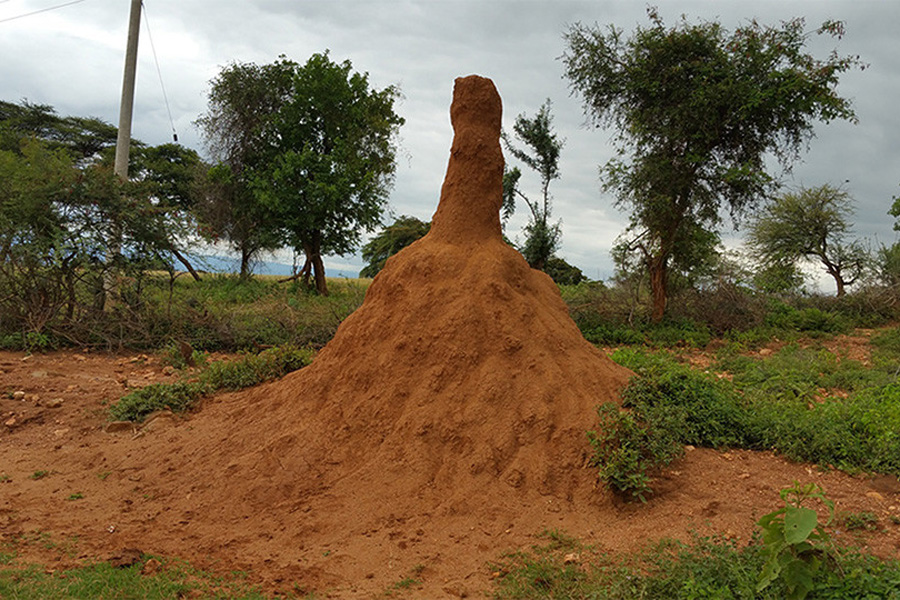By: Bill Wellock | Published: | 8:49 am | SHARE:
When FAMU-FSU Assistant Professor of Mechanical Engineering Neda Yaghoobian looks at a termite mound, she sees more than a pile of dirt. She sees an engineered structure.
Termite mounds, with their odd shapes, are designed naturally by termites to provide livable spaces for their residents — just like human-designed buildings.
Yaghoobian and her students are interested in understanding the fundamental physics that govern termite mounds’ odd-shapes and their functions for termites. Understanding how the mounds are shaped and ventilated could help humans develop efficient ways of natural ventilation for their own buildings, which would save energy.
Because termites don’t have electricity, their HVAC systems need to work passively. The shape of their structures adapts to and works with the local environment to provide a suitable environment for the residing termites. The question is how.
In two separate papers published in Royal Society Open Science and Physics of Fluids, Yaghoobian and her team explain how they built computational models to help understand heat transfer and ventilation within the mounds.
Through these models, they found that the angles of termite mounds’ spires were affected by the angle at which the sun hit them. They also found that a vortex of wind at the entrance to the chimney affected the pressure gradient inside the mound, which determined how well air was sucked out of the mound.
“This research uses detailed computational modeling for the first time to shed new light on the understudied ventilation mechanism of termite mounds,” Yaghoobian said. “A better understanding of these natural structures with their efficient passive ventilation systems can help us in improving the ventilation mechanisms in our buildings and saving energy.”
Termite mounds have been a subject of hot, dusty fieldwork for decades, but using detailed computer modeling to better understand how they work is a novel endeavor.
“Field experiments have certain limitations and are expensive,” Yaghoobian said. “It is not possible to work on more than a few mounds at once and it is expensive to monitor them throughout the whole year, for example. When you do numerical work, it gives you freedom to check many things. We can adjust the parameters — like location, solar radiation, wind speed, soil material and more — to see what changes in the model.”
In the Royal Society Open Science paper, researchers tested an existing theory that the angle of the sun at noon directly affects the towering spires of dirt that topped termite mounds in Africa. The researchers built a model that predicted the shapes and features of mounds according to the principles of thermodynamics and heat transfer. Their computations came up with prototypes for mounds that were optimized for various real-world locations. They compared their simulated mounds with actual examples.
The model chose shapes that were very close to what they saw in nature.
As the locations they studied moved closer to the equator, the tilt of the spires decreased. When they observed mounds on the equator, the spires pointed straight into the sky. They also found that mounds that received more solar energy had more intricate channels inside the mound.
In the Physics of Fluids paper, the researchers built another computational model that investigated the ways that variations in heat and wind affected the movement of air within mound chimneys – the ventilation mechanism in termite mounds.
In addition to finding that the wind at the entrance of the chimney affected the pressure gradient inside the mound, researchers also discovered factors that affected the mounds’ overall air movement. A temperature gradient deeper within the chimney determined the chimney’s ventilation efficiency. Although daytime and nighttime temperature gradients at the sites they studied were similar, the small differences between them were enough to double the mounds’ ventilation capacity during the day compared to night.
Tadeu Mendonca Fagundes, a doctoral student in mechanical engineering, and Juan Carlos Ordonez, a professor with the FAMU-FSU College of Engineering, contributed to the Royal Society Open Science paper. Saurabh Saxena, a doctoral student in mechanical engineering, contributed to the Physics of Fluids paper. These studies were supported by Florida State University and the FAMU-FSU College of Engineering.
Original post https://alertarticles.info
